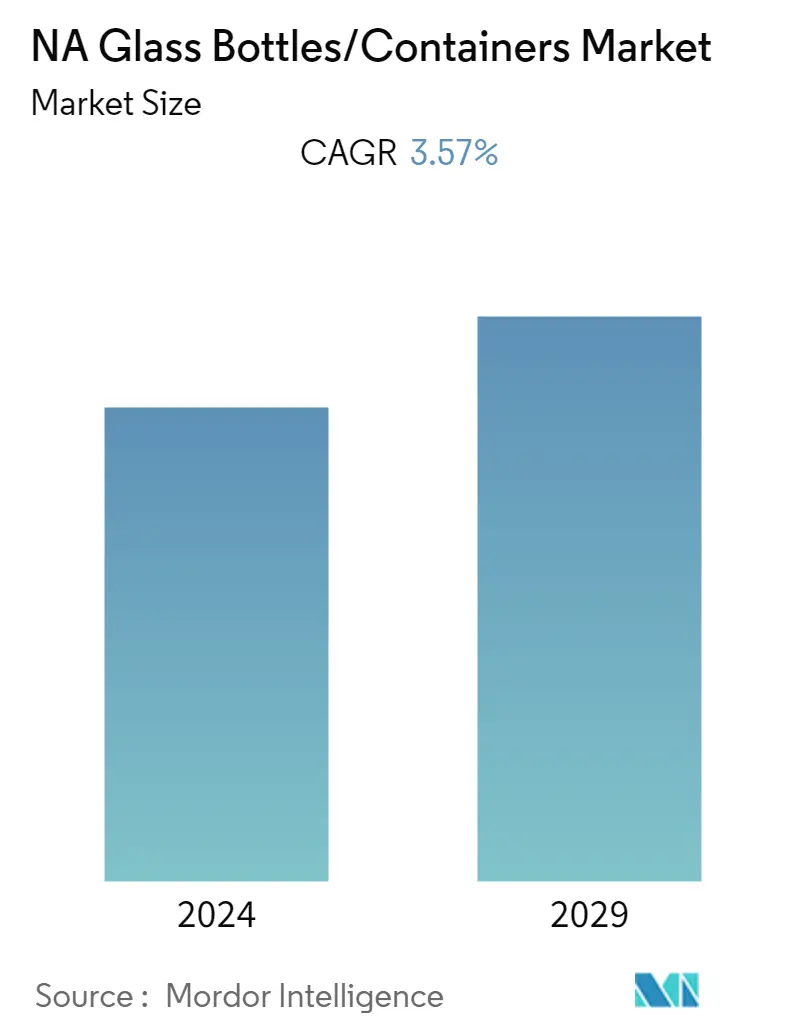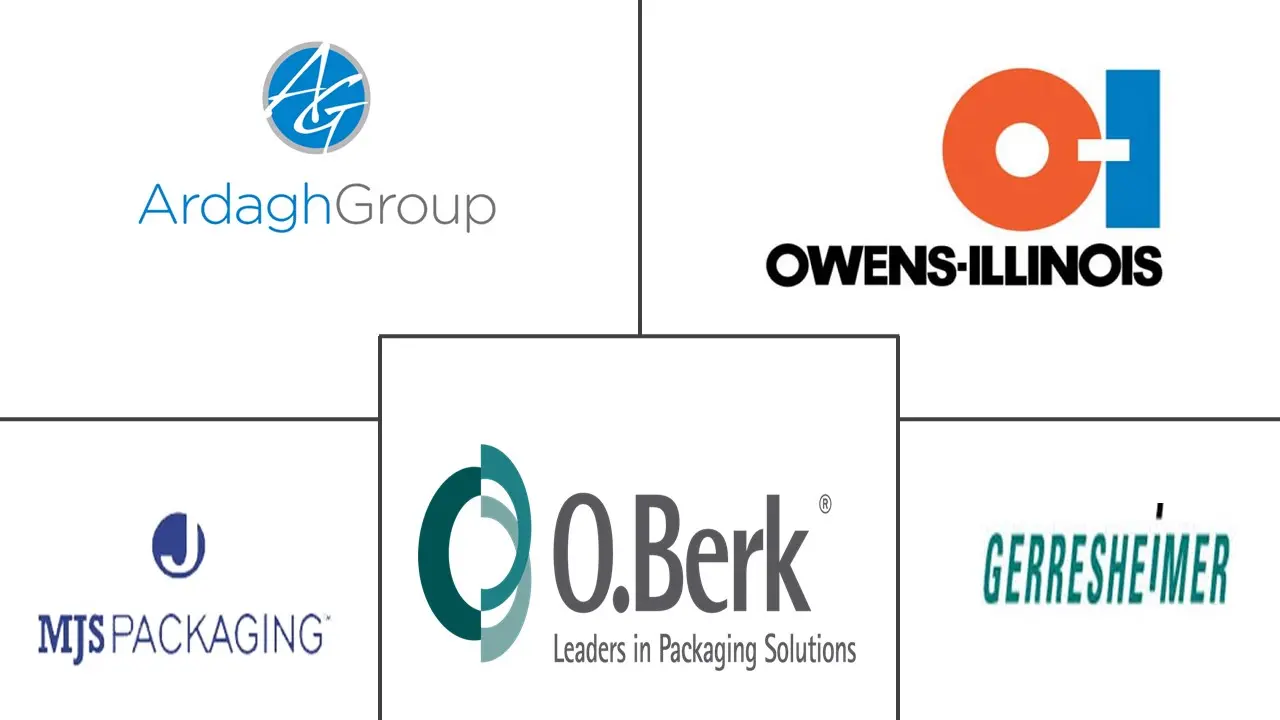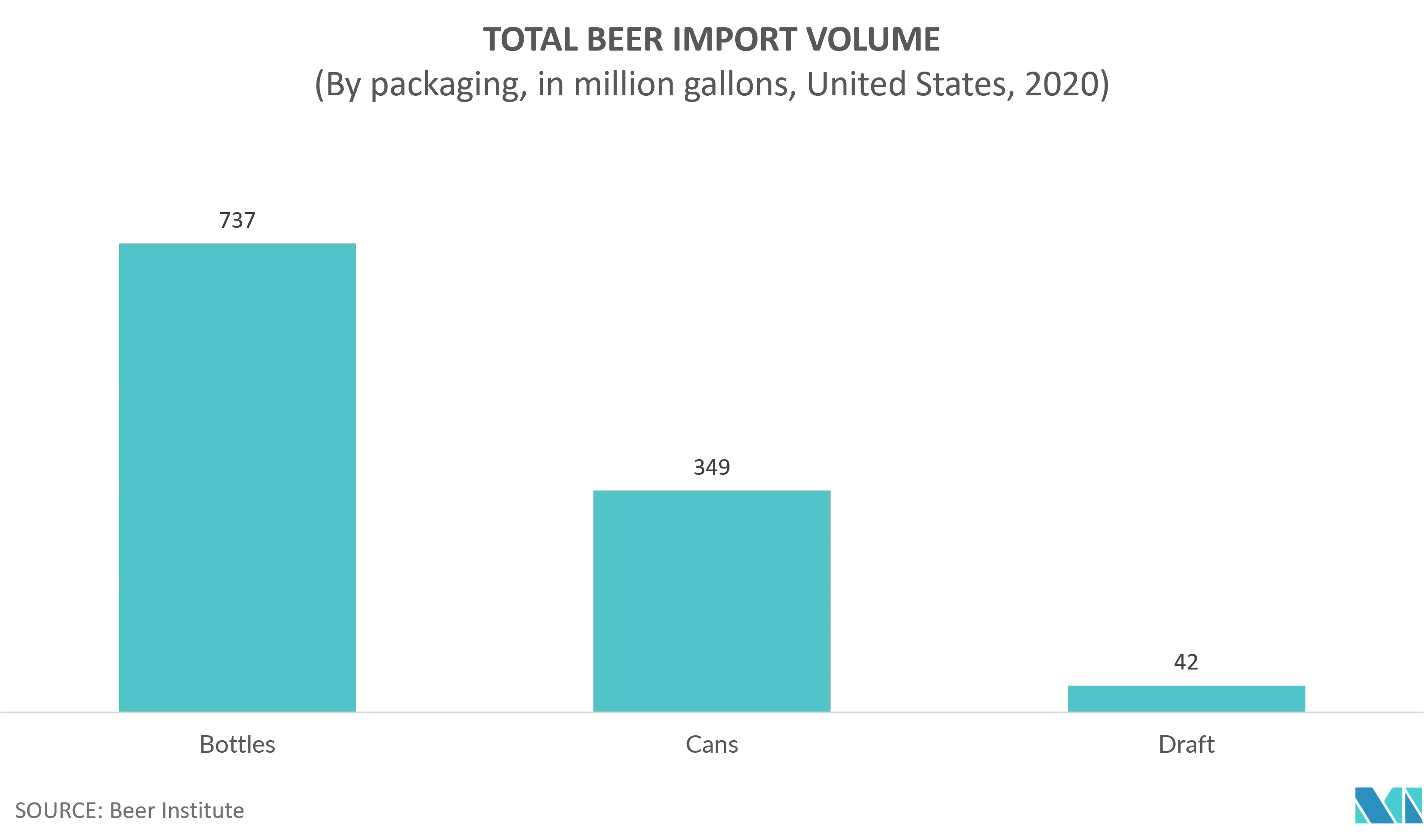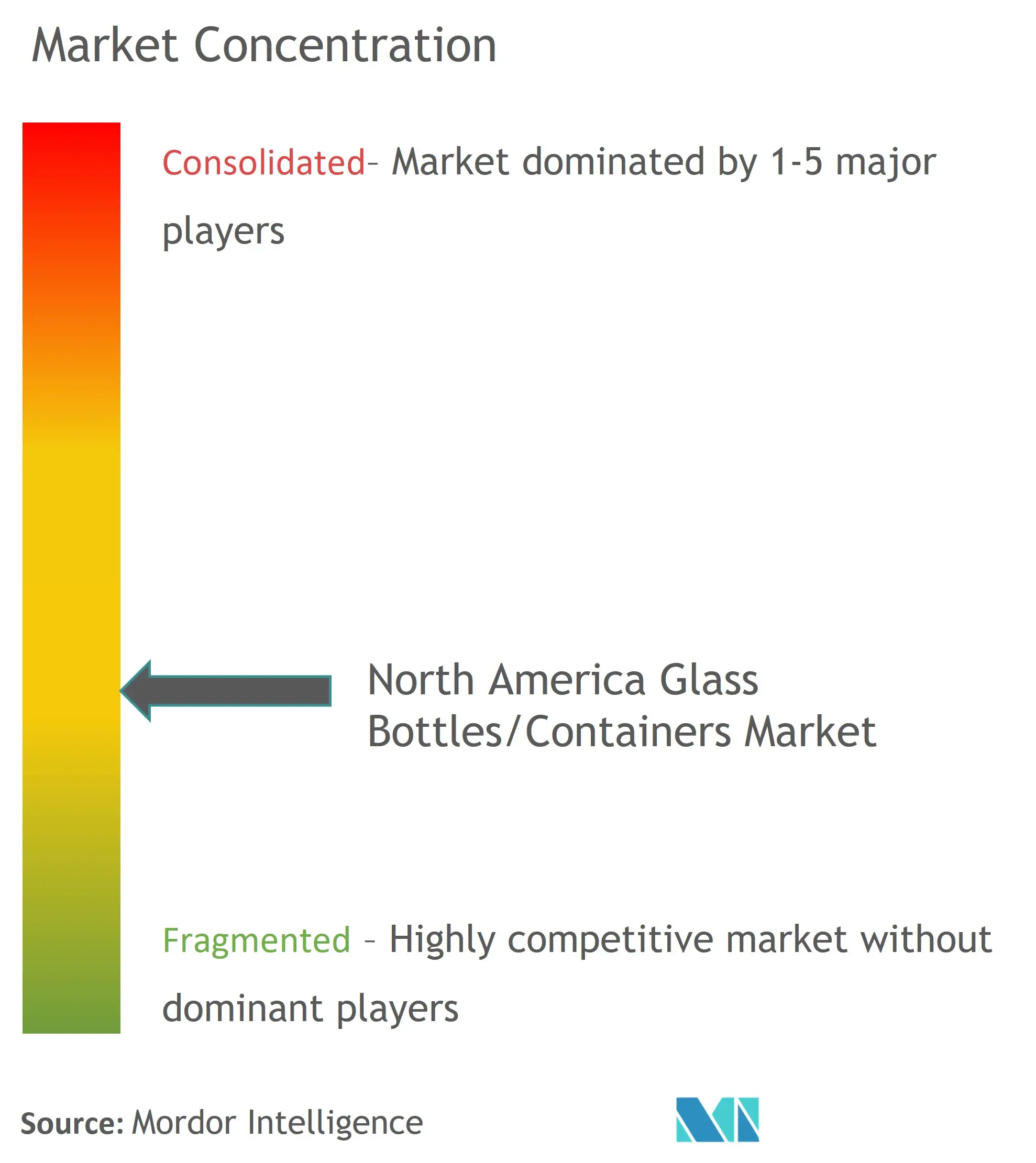North America Glass Bottles/Containers Market Size

| Study Period | 2019 - 2029 |
| Base Year For Estimation | 2023 |
| Forecast Data Period | 2024 - 2029 |
| Historical Data Period | 2019 - 2022 |
| CAGR | 3.57 % |
| Market Concentration | Low |
Major Players
*Disclaimer: Major Players sorted in no particular order |
North America Glass Bottles/Containers Market Analysis
The North America Glass Bottles and Containers Market is expected to reach a CAGR of 3.57% during the forecast period (2021 - 2026). Glass packaging is considered for premium products and a gold standard in various industries such as pharmaceuticals, food and beverages, cosmetics, and liquor packaging. The demand, however, is fluctuating across various markets due to the impact of COVID-19 on the performance of the end-user industry in global markets.
- The beverage industry holds a prominent share of the regional packaging demand for glass. With the outbreak, the COVID-19 liquor industry observed a significant drop in demand though it was deemed an essential industry by governments.
- The beer industry has been witnessing a dramatic decline in retail sales and jobs. In September 2020, the Beer Institute, in partnership with the Brewers Association (B.A.), the National Beer Wholesalers Association (NBWA), and the American Beverage Licensees (ABL), released a report from a leading economic firm showing more than 568,000 jobs supported by the U.S. beer industry disappeared in 2020 due to the COVID-19 pandemic. These job losses include more than 3,200 brewing jobs, 1,700 distributing jobs, and 360,000 retail-related jobs. The report concluded that the COVID-19 pandemic resulted in a USD 20 billion decline in retail beer sales.
- In February 2020, Ardagh Group Glass - North America announced a long-term supply agreement with Copper Cane Wines & Provisions to manufacture all its 750ml wine bottles in the United States., beginning with its Vintage Series. This partnership connects Napa Valley's Copper Cane Wines & Provisions with Ardagh's Madera, California, glass manufacturing facility, helping to keep the winery's promise to stay local and sustainable by reducing its environmental footprint.
- While the demand for glass bottles dropped for Beverage packaging during the pandemic, the pharmaceutical sector demanded increased production of glass vials to contain the COVID-19 vaccines. For instance, in May 2020, the White House launched Operation Warp Speed (OWS) to find the vaccine by January 2021, and approved partnerships worth USD 347 million with two American vial makers, SiO2 and Corning, to fight the global glass vial shortage ahead of a coronavirus vaccine rollout. It's a partnership run by various government departments, including HHS, the Defense Department, BARDA, National Institutes of Health, FDA (Food and Drug Administration), and Centers for Disease Control and Prevention.
- Moreover, many companies have been developing a newer range of vials, such as, in February 2021, Corning stated that its vials are made with Valor glass that are very strong and can be filled much more quickly at manufacturing sites, thereby increasing the speed of production by up to 50%. As the company is looking forward to supplying 1.2 Billion Doses, it is a potentially crucial feature due to the requirement of vaccine doses in as short a time as possible. The company has a manufacturing facility in North Carolina dedicated to making valor glass.
North America Glass Bottles/Containers Market Trends
This section covers the major market trends shaping the North America Glass Bottles/Containers Market according to our research experts:
Beverages Segment is Expected to Witness Significant Growth
- Beverages hold the maximum market share in the market studied. With consumers getting increasingly careful about what they consume and in what material it is packaged, the perception towards glass is increasingly becoming positive due to the prime reason that glass is the neutral packaging material with an almost zero rate of chemical interaction, ensuring product integrity.
- For instance, in March 2020, Ardagh Group, Glass expanded its production at Wilson, North Carolina, plant. It partnered with O'Connor Brewing Company to manufacture all of its 12oz long-neck glass bottles. The 12oz long-neck amber beer bottles for O'Connor Brewing Company are likely to be designed and manufactured by Ardagh Group using 100% recyclable amber glass.
- As more and more population is turning toward eco-friendly solutions to increase their contribution, glass packaging is seen as an endless recyclable alternative to plastic packaging. Glass can be 100% recycled as well as re-usable, without losing quality. According to a survey by G&S Business Communications, glass bottles and jars came out on top, with 57% of the US consumers believing that it is the most sustainable.
- Besides, governments across the world are imposing bans on plastic packaging in beverages, due to which beverage companies, such as Coke and PepsiCo, are trying to avoid plastic packaging. For instance, PepsiCo is looking to prevent the use of 67 billion plastic bottles through 2025, and the alternate for that is expected to be glass bottles.
- Moreover, industry estimates have suggested that the US on-premise channel sells accounts USD 10 billion of alcohol. But, as per Rabobank's survey, the ban on sit-down dining could lead to losses of between USD 15-20 billion in alcohol. Whereas, on the e-commerce channels for alcohol sales are picking up rapidly. For instance, the delivery platform named Drizly announced that sales from new customers have been 500% higher, along with sales from repeat customers increased to 125%.

United States is Expected to Account for Major Market Share
- The United States is one of the strongest packaging markets worldwide and consists of many key players producing glass bottles and containers for food and beverage, personal care, and pharmaceutical products, among others. As the economy is continuously growing, increasing consumer spending on food and beverages and personal care is driving the demand for glass bottles and container packaging solutions.
- Alcoholic beverages dominated the glass bottles segment in the United States. A high percentage of distilled spirits and wines are packaged using glass containers, while in the beer segment, the percentage of glass containers has decreased significantly. On the other hand, in the non-alcoholic segment, glass holds a tiny percentage and is used in CSDs, milk, and newer ready-to-drink beverages.
- In 2020, 82% of all beer was domestically produced, and 18% was imported from more than 100 different countries around the world (source: U.S. TTB and U.S. Commerce Department, 2021). The alcohol beverage marketplace and the three-tier system have evolved rapidly over the years. Since 2012, over 2,300 alcohol beverage laws have been passed around the country (Source: NBWA Industry Affairs, 2021). Such instances address the major adoption of glass packaging.
- Moreover, glass packaging is the most dominant form of wine packaging. The properties of glass are well suited to the nature of wine, not matched by plastic or even metals. According to Beverage Information Group, in July 2020, the consumption of table wine amounted to approx. 310.72 million 9-liter cases in the United States.

North America Glass Bottles/Containers Industry Overview
The degree of competition depends on various factors affecting the market, such as brand identity, powerful competitive strategy, and degree of transparency. The major factors governing this force are a sustainable competitive advantage through innovation, levels of market penetration, barriers to exit, power of competitive strategy, and firm concentration ratio. With innovations in this market, the sustainable competitive advantage is growing. For instance, The level of market penetration is high, while advertising expense is moderate. The power of competitive strategy is also supportive, while the firm concentration is moderate. As strong brands are synonymous with good performance, long-standing vendors are expected to have the upper hand. With many large players actively competing in the market, the competitive rivalry within the industry is High.
- September 2020 - Owens-Illinois launched an innovation, O-I: EXPRESSIONS, to transform glass bottle design through the use of digital printing and will offer customization and personalization by sculpting glass bottles into multi-dimensional works of art. Moreover, the company is also focused on rolling out its reuse process and partnered with Oregon Beverage Recycling Cooperative (OBRC) to give the charge for refillable bottles in the United States. OBRC is the entity that operates for picking up and processing approximately all the containers redeemed in the country.
- November 2020 - Hybrid packaging supplier Berlin Packaging expanded its Canadian presence with the packaging supplier Consolidated Bottle acquisition. The combined businesses are expected to offer even more packaging solutions and value-added services to their customers, thereby catering to the growing demand for glass bottles in the country.
North America Glass Bottles/Containers Market Leaders
-
Owens-Illinois Inc.
-
Ardagh Packaging Group PLC
-
Gerresheimer AG
-
MJS Packaging
-
O.Berk KOLS Containers, Inc.
*Disclaimer: Major Players sorted in no particular order

North America Glass Bottles/Containers Market News
- February 2021 - Kraft Heinz Canada announced that Heinz ketchup is partnering with Loop, a state-of-the-art circular reuse platform designed to eliminate waste. Canadians in the Greater Toronto Area can order Heinz ketchup from Loop at Loopstore.ca. Kraft Heinz Canada's partnership with Loop makes it easy for Canadians to choose more sustainable options that are safe, sanitary, and impactful. The distinctive glass Heinz ketchup bottle is designed for repeat use and is delivered through a reusable, fully circular packaging initiative. Loop collects empty containers after use and works with manufacturers like Heinz to sanitize and refill them.
North America Glass Bottles/Containers Market Report - Table of Contents
1. INTRODUCTION
- 1.1 Study Assumptions and Market Definition
- 1.2 Scope of the Study
2. RESEARCH METHODOLOGY
3. EXECUTIVE SUMMARY
4. MARKET INSIGHTS
- 4.1 Market Overview
-
4.2 Industry Attractiveness - Porter's Five Forces Analysis
- 4.2.1 Threat of New Entrants
- 4.2.2 Bargaining Power of Buyers
- 4.2.3 Bargaining Power of Suppliers
- 4.2.4 Threat of Substitutes
- 4.2.5 Intensity of Competitive Rivalry
- 4.3 Industry Value Chain Analysis
- 4.4 Industry Policies
-
4.5 Market Drivers
- 4.5.1 Higher Disposable Income and Integration in Premium Packaging
- 4.5.2 Improved Technology Offering Better Solutions
-
4.6 Market Restraints
- 4.6.1 High Competition from Substitute Packaging Solutions
- 4.6.2 Operation and Logistical Concerns
5. MARKET SEGMENTATION
-
5.1 By End-user Vertical
- 5.1.1 Beverages
- 5.1.1.1 Alcoholic
- 5.1.1.1.1 Liquor
- 5.1.1.1.2 Beer
- 5.1.1.1.3 Soft Drinks
- 5.1.1.1.4 Milk
- 5.1.1.2 Non-Alcoholic
- 5.1.1.2.1 Carbonated Soft Drinks
- 5.1.1.2.2 Milk
- 5.1.1.2.3 Water and Other Non-Alcoholic
- 5.1.2 Food
- 5.1.3 Cosmetics
- 5.1.4 Pharmaceutical
- 5.1.5 Other End-user Verticals
-
5.2 By Country
- 5.2.1 United States
- 5.2.2 Canada
6. COMPETITIVE INTELLIGENCE
-
6.1 Company Profiles
- 6.1.1 Owens-Illinois Inc.
- 6.1.2 Ardagh Packaging Group PLC
- 6.1.3 Gerresheimer AG
- 6.1.4 Arkansas Glass Container Corporation
- 6.1.5 MJS Packaging
- 6.1.6 O.Berk KOLS Containers, Inc.
- 6.1.7 Kaufman Container
- 6.1.8 Burch Bottle & Packaging
- 6.1.9 Roy+Leclair Emballage and Packaging
- *List Not Exhaustive
7. INVESTMENT ANALYSIS
8. FUTURE OF THE MARKET
** Subject To AvailablityNorth America Glass Bottles/Containers Industry Segmentation
Glass bottles and containers provide an ideal way to keep the consumables safe, fresh, and healthy for a longer period and ease transport. Glass bottles and containers are majorly used in the alcoholic and non-alcoholic beverage industry due to their ability to maintain chemical inertness sterility and non-permeability. As part of the scope of the market, key end-user industries, such as beverage, food, pharmaceutical, and cosmetics, have been considered.
| By End-user Vertical | Beverages | Alcoholic | Liquor |
| Beer | |||
| Soft Drinks | |||
| Milk | |||
| By End-user Vertical | Beverages | Non-Alcoholic | Carbonated Soft Drinks |
| Milk | |||
| Water and Other Non-Alcoholic | |||
| By End-user Vertical | Food | ||
| Cosmetics | |||
| Pharmaceutical | |||
| Other End-user Verticals | |||
| By Country | United States | ||
| Canada |
North America Glass Bottles/Containers Market Research FAQs
What is the current NA Glass Bottles/Containers Market size?
The NA Glass Bottles/Containers Market is projected to register a CAGR of 3.57% during the forecast period (2024-2029)
Who are the key players in NA Glass Bottles/Containers Market?
Owens-Illinois Inc. , Ardagh Packaging Group PLC, Gerresheimer AG, MJS Packaging and O.Berk KOLS Containers, Inc. are the major companies operating in the NA Glass Bottles/Containers Market.
What years does this NA Glass Bottles/Containers Market cover?
The report covers the NA Glass Bottles/Containers Market historical market size for years: 2019, 2020, 2021, 2022 and 2023. The report also forecasts the NA Glass Bottles/Containers Market size for years: 2024, 2025, 2026, 2027, 2028 and 2029.
North America Glass Bottles/Containers Industry Report
Statistics for the 2024 North America Glass Bottles/Containers market share, size and revenue growth rate, created by Mordor Intelligence™ Industry Reports. North America Glass Bottles/Containers analysis includes a market forecast outlook to 2029 and historical overview. Get a sample of this industry analysis as a free report PDF download.



